Being one of our most emblematic wildflowers, the fabled Flannel Flower is an iconic flowering plant from Sydney that features unique floral displays and silvery foliage. It is garnering a sought-after reputation for its use as an ornamental addition to landscapes that can easily add a wow factor to any setting.
This herbaceous small shrub sports distinctive silvery green to grey foliage with fine hairs that presents the colours in its stems, branches and leaves, making this plant an all-round stunner.
Here is everything you need to know to grow and care for this famed native shrub in your garden.
More...
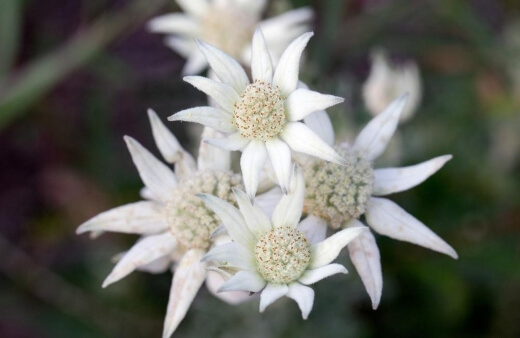
Family: | Apiaceae |
|---|---|
Genus: | Actinotus |
Species: | A. helianthi |
Common Names: | Flannel flower, Federation stars |
Location: | Outdoor |
Type: | Small shrub |
Growth: | 0.3 to 1.2 metres tall, 0.3 to 0.5 metres wide |
Sun requirements: | Full sun to light shade |
Foliage Colour: | Silvery green |
Flower Colour: | White |
Flowering: | Spring to summer |
Maintenance level: | Low |
Poisonous for pets: | Non-toxic to cats and dogs |
This shrub produces attractive silvery lobed leaves beneath the eye-catching 10-pedicelled white daisy-shaped flowers on gently arching stems. Its form is open with a mound-shaped growth habit, making it a great choice for many different styles of gardens.
The notorious flowers have been used in local imagery and art since colonial times and the plant has been named for its flannel-like flower texture. Enjoy this shimmering argent native species in your garden by following our helpful guide below.
Introducing the Flannel Flower
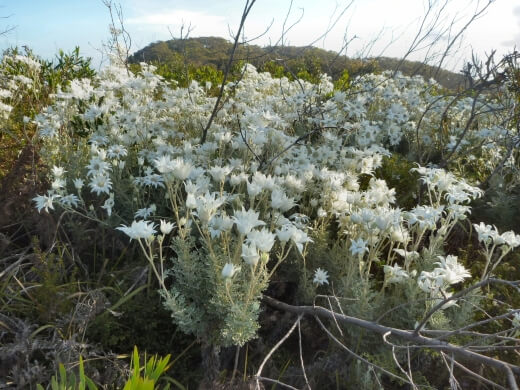
Source: gardeningwithangus.com.au
Scientifically named Actinotus helianthi which can be translated to “furnished with rays”, common names now include flannel flower and Federation stars, both of which refer to the shrub's stary floral displays.
The plant is native to bushland around Sydney and it forms a part of the carrot and celery family, Apiaceae. Before the Waratah, the flowers were the floral emblem for New South Wales, paying homage to the plant’s incredible blooms.
In cultivation, Actinotus helianthi will grow at a moderate rate to around 0.3 to 1.2 metres tall and 0.3 to 0.5 metres wide. It can grow in all areas of Australia except for the tropics.
In colder climates, it may need to be positioned in a warm and sheltered location to ensure it survives the winters. One caveat to establishing this native shrub is that they tend to be a short-lived species.
However, they self-seed well in good conditions if allowed to. Common landscaping applications include:
- An addition to or near rockeries - click here to find out how to set up and get into rock gardening.
- Decorative container plant
- Feature plant (wow-factor)
- Border planting
- Mass plantings for white or silver-themed gardens
- Attractive gap filling in beds
Thanks to the plant's impressive flowers and foliage, it can seamlessly integrate itself into most garden settings. They are however commonly planted in cottage-style gardens, native gardens, flower gardens and coastal gardens.
The flowers will attract native insects, bees and butterflies. The cut flowers will make for an excellent addition to floral arrangements that can be used to further elevate your home’s décor.
How to Grow Flannel Flowers
Unfortunately, seed germination of flannel flowers tends to be quite unreliable but not impossible. These shrubs can be reliably propagated using stem cuttings, which tends to be the preferred method of growing.
Be an expert in taking plant cuttings with the help of our complete guide here.
Alternatively, purchasing a young and healthy nursery plant and transplanting it into your landscape is always a less intensive, safer way to establish a flowering plant.
Nursery plants are best established once the danger of frost has passed.
Flannel Flower Propagation
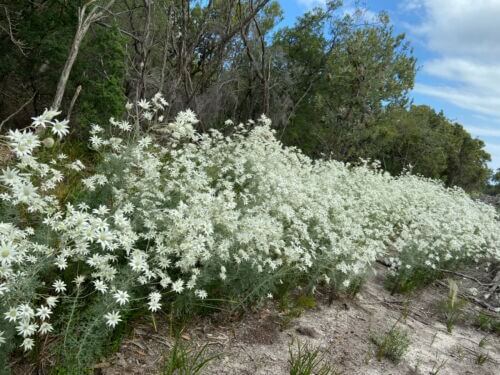
Source: ebay.com.au
Growing Actinotus helianthi from Seed
To prepare the seeds for a better chance of germination, you can rub or scratch the seeds on a large wire strainer and then place them in water.
You can also soak them then nick the seed coatings with a sharp knife to scarify them or safely light a small fire over the seeds in a punnet to lightly burn them.
Try to ensure you use seeds that are somewhat fresh, no older than about 6 months.
- Once your seeds are prepared and dry, sow them lightly into your potting medium or seed-raising mix in well-drained seed containers. A mixture of equal parts of a quality potting mix, sand and some perlite should work great.
- Water very lightly after sowing the seeds then place the containers in a warm, sheltered location away from direct light.
- Depending on the conditions, these fussy seeds can germinate after 30 days or take up to a full year to sprout. Be patient and don’t give up on them, the seeds will normally only germinate when conditions are perfect.
- Try to avoid placing the seeds in a location that is warmer than 30°C.
- Once your seeds have sprouted, you can slowly and gently transplant the young seedlings into larger containers as needed and introduce more light as they grow.
- Water to keep the soil mixture lightly moist and fertilise young plants in the growing seasons as flannel flowers are known to be heavy feeders.
- Allow seedlings to grow to at least 30cm in height before transplanting them into the garden.
Propagating Flannel Flower Using Cuttings
- Using a sharpened and sterilised pair of secateurs (check out our review of the best secateurs here), take your tip stem cutting in spring from a disease-free, established parent plant.
- Each cutting should be at least 6 to 10 centimetres long for the best results and should have a few leaves and nodes on it.
- Prepare well-draining containers filled with a quality potting mix.
- Plant the cuttings with the soft end part that has been cut into the mix facing downwards.
- Lightly water the cuttings after planting then place them in a warm, humid location with some filtered light.
- Mist the cuttings as needed to boost humidity and aim to keep the soil lightly moist at all times.
- Cuttings strike best when planted in individual trays or containers so that the roots aren’t disturbed too much while working with the growing plants.
Ideal Conditions for Planting Flannel Flowers
Generally, these native shrubs are pretty tolerant to a wide range of conditions but will naturally thrive given ideal conditions. For a disease-free, beautifully blooming specimen, ensure that you are sticking to these outlines as close as you can within your landscape.
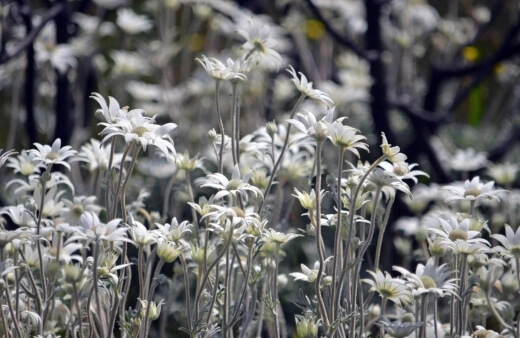
Sunlight for Actinotus helianthi
The plant will thrive and flower best in a sunny position but it will be able to grow in partially shaded spots too. Aim to give the plant about 6 hours of full sun each day with some early morning and late afternoon shade.
Ideal Soil Conditions
These plants love sandy soils with good drainage. They naturally grow in sandy soil types so by providing this, they will thrive. Ensure your soil has a pH of between 5.5 and 6.5 for the best results.
For container-grown plants, use a quality potting mix. Not sure how to test your soil? Check out this 3-in-1 Soil Tester Kit for reference.
Planting Flannel Flower Positions
When choosing your planting site, be sure to try and avoid spots that get strong winds as these shrubs can be sensitive to this. Also, be sure to choose your site wisely as flannel flowers despise being transplanted as they are extremely sensitive to root disturbances.
You should also, therefore, take a little extra care when weeding around the plant. For mass planting situations, space each plant 0.5 to 1 metre apart for the best results.
Caring for Flannel Flowers
Once established, Actinotus helianthi will be drought tolerant and shouldn’t require too much hassle in terms of maintenance and care. Being well-adjusted to most of our endemic conditions, you can be sure you’ll enjoy a mostly fuss-free addition to your garden.
Here are some of the ways you can go the extra mile for your plant to ensure it appears as healthy and prolific as possible.
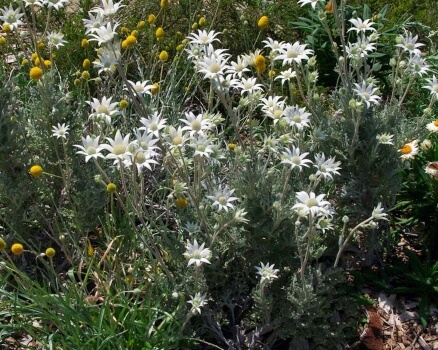
Source: gardensonline.com.au
Water Needs
Young plants will need to be watered regularly until established. Thereafter, the plants will only need occasional watering. When watering, avoid wetting the leaves and stems to discourage fungal spores from forming.
Water only when the top surface layer of soil feels dry to the touch. In very hot and long summers, additional waterings may be necessary.
Fertilising Federation Stars
It is considered best practice to feed your shrub with a balanced control-release garden fertiliser and some quality liquid plant food in spring to late summer to promote healthy new growth and bigger blooms. Feed every 4 weeks or so during this active season.
Mulch for Moisture
In summer, mulch with an organic mulch to a depth of about 100mm to help with moisture retention. Mulch only around the base of the plant, being sure to avoid letting the mulch touch or cover the main stems on the ground.
Find out more about the types of mulch as well when and how to use them here.
Pruning Flannel Flowers
After flowering in late summer, lightly prune back the stems and leaves to maintain a bushy appearance. Tip pruning is also an excellent way to go about trimming these shrubs as this will allow for many sites for future flowering.
Click here for more tips on pruning Australian natives.
When pruning, be sure to wear protective gardening gloves (like these gardening gloves) as long exposure to the plant’s fine hairs can cause skin irritation in some individuals.
Actinotus helianthi as Cut Flowers
As mentioned, these stunning blooms work fantastically in cut flower arrangements, easily elevating the appeal of any vase and space indoors. Though short-lived, usually up to 2 weeks, the cut flowers are certainly a worthy inclusion for your floral décor around the house.
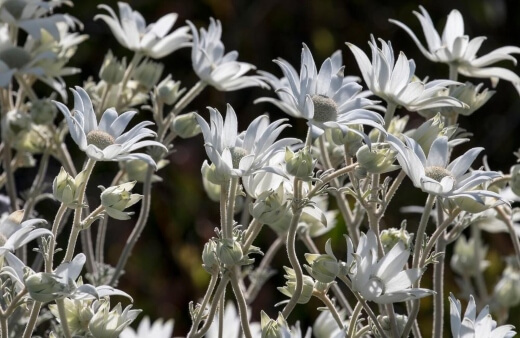
When pruning in late summer, cut the healthiest and biggest flowers at a 45° angle on the stems. Place them in fresh clean water straight away and provide them with some cut-flower food.
Check the flowers daily as they tend to consume a lot of water. Be sure to always use clean tools when snipping and also use clean vases or containers for your cut flower arrangements.
Here are some stunning vases to choose from here if you need some inspiration.
Common Flannel Flower Pests & Diseases
As with many outdoor flowering plants, these shrubs can also be susceptible to certain issues, especially in warmer environments. Luckily, these small problems can be treated with ease and they shouldn’t cause long-term damage if treated promptly.
Caterpillars/Aphids/Scale Insects/Mealybugs
These leaf-consuming pests can cause unwanted visual damage to your plant’s foliage. While harmless in small numbers, larger infestations will need to be dealt with to protect the longevity of your plant.
Be sure to regularly check for any insect residue or eaten foliage to ensure you deal with these pests as soon as possible. To treat, apply an organic insecticide or neem oil spray every 2 to 3 weeks to rid your shrub of infestation.
Water lightly after each treatment and be sure to remove any damaged or infested foliage as needed.
Fungal Infections
To prevent any fungal issues from forming, be sure to always avoid wetting the foliage when watering, be sure to disturb the roots as little as possible and try to make sure your plant is getting enough light and not too much water.
If you notice any signs of fungal infection like discoloured spores, leaf spots or soggy roots and stems, you will need to treat the plant with an appropriate fungicide.
Flannel Flower Frequently Asked Questions
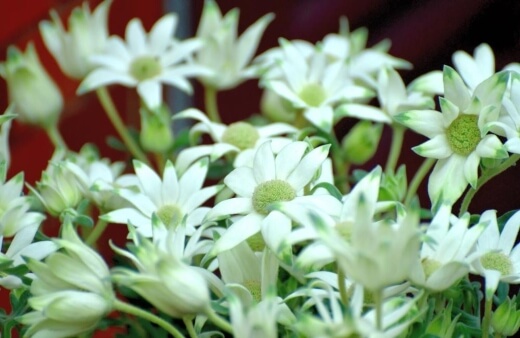
What does the flannel flower represent?
The flower is now Australia’s symbol for mental health awareness. It used to be the floral emblem for NSW.
How long do flannel flowers live?
Flannel flowers may last for up to three years if properly cared for.
What do flannel flowers smell like?
Some say the blooms have a honey-like scent within gardens and floral arrangements.
How do you dry flannel flowers?
To dry, hang the cut flowers upside down in a well-ventilated, dark room.
Interested in also establishing other gorgeous native flowering plants in your garden? Be sure to check out our list of 30 best endemic flowers in Australia.
Forge Flamboyant Outdoor Spaces with the Famed Flannel Flower
With its iconic white flowers and highly decorative silvery foliage, the flannel flower is an easy choice for any gardener looking for a native ornamental flowering shrub.
With so many attractive applications within landscapes, this plant will certainly impress and quickly give you that wow factor in your garden.
Plant it alongside other flowering plants, natives or as a stand-alone feature to get the most of its stunning silvery hues in your outdoor spaces. Enjoy unparalleled texture and colour in your garden with the flannel flower.
Published on August 18, 2022 by Gary Clarke
Last Updated on April 2, 2024




